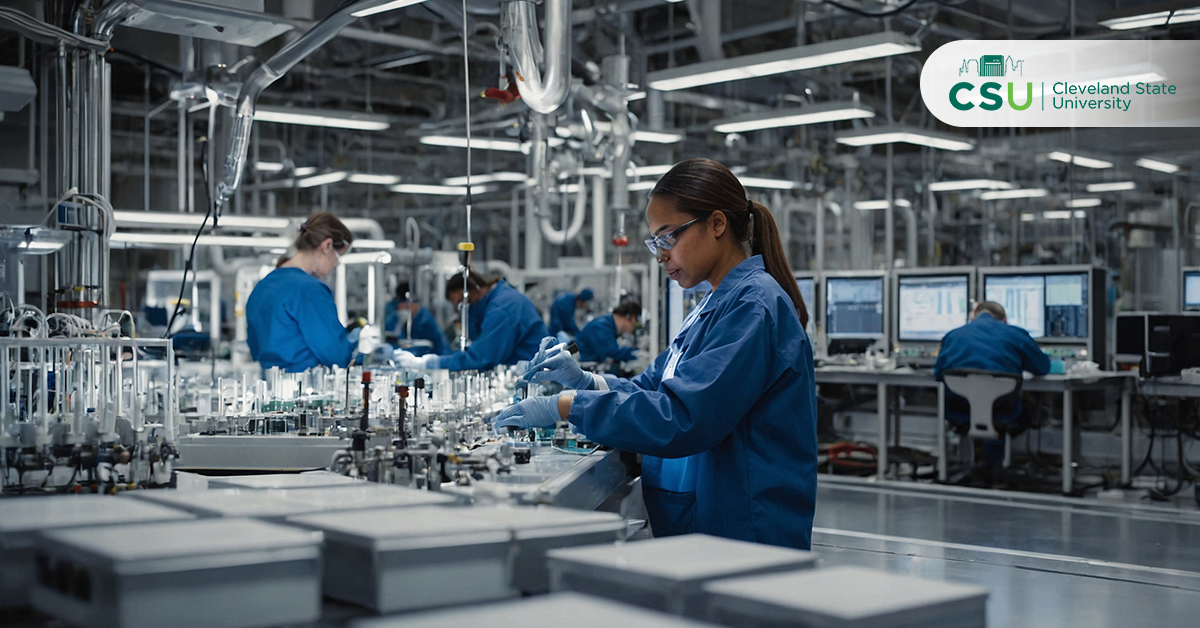How CSU is Shaping the Next Generation of Semiconductor Professionals
The World Runs on Chips – And So Do Our Lives!
Imagine this: You’re about to send an urgent email, but your laptop freezes. You restart it—nothing. Your phone’s battery dies at the same time, and suddenly, you're disconnected.
Annoying, right?
Now scale that up—a global chip shortage shuts down entire industries. Impossible? Not really! In 2021, automakers like Ford and General Motors actually had to halt production because they couldn't get enough microchips. Want another example of how disruptive these little microchips can be? The PlayStation 5 and Xbox Series X were out of stock for months because chipmakers couldn’t keep up with demand. How about that?
As tiny as they are, semiconductor chips are the heartbeat of modern technology—powering everything from smartphones and electric vehicles to AI systems and medical devices. But here’s the real shocker:
The World is Running Out of Semiconductor Professionals!
The semiconductor industry is growing exponentially, yet there aren’t enough skilled professionals to keep up with demand. For students, this means one thing—an incredible career opportunity!
So, let’s get to the big question:
Is a Career in Semiconductors a Smart Choice? What’s the Opportunity for You?
Here’s a quick look at the salaries offered for some of the roles in the semiconductor industry

Why Are Semiconductors the Talk of the Town?
If you were following the news in the past few years, you probably heard about the global chip shortage that sent industries into a panic. But what caused it?
- COVID-19 changed consumer demand. People bought more electronics—laptops, tablets, gaming consoles—but semiconductor factories couldn’t keep up.
- The automotive industry miscalculated. Car manufacturers scaled back chip orders in 2020, thinking sales would drop. When demand surged again, there weren’t enough chips available.
- Geopolitical tensions disrupted supply chains. The U.S. realized it was heavily reliant on Asian chip manufacturers like TSMC in Taiwan and Samsung in South Korea. In October 2024, TSMC inadvertently supplied chips that ended up in Huawei products, raising concerns about shadow networks bypassing U.S. sanctions. This led to stricter regulatory scrutiny and reinforced the need for transparent, secure semiconductor supply chains.
- Intel’s struggle to reclaim dominance. As of October 2024, Intel has faced significant hurdles. Despite major investments in U.S. manufacturing, the company has struggled with production setbacks, internal conflicts, and financial declines. These challenges have been worsened by missed opportunities in AI and difficulties with new manufacturing processes, making Intel’s road to industry leadership more complicated than expected.
The shortage exposed the fragility of the semiconductor supply chain, prompting the U.S. government to act fast. And, here are some of the outcomes of that rapid action.

$52.7 Billion Investment – The CHIPS and Science Act
- The CHIPS and Science Act is a landmark initiative aimed at strengthening domestic semiconductor manufacturing, research, and development in the United States.
- With a $52.7 billion investment, the act is designed to boost the production of advanced semiconductors, reduce dependence on foreign suppliers, and create a more resilient supply chain.
- This funding is expected to fuel job creation, support innovation, and position the U.S. as a leader in the global semiconductor industry.
Over 100,000 New Jobs – The Growing Demand for Skilled Semiconductor Professionals
- The U.S. semiconductor industry is projected to experience significant workforce expansion, with an estimated 115,000 additional skilled professionals needed by 2030.
- As semiconductor demand continues to grow across industries such as AI, healthcare, automotive, and consumer electronics, the need for engineers, technicians, and process specialists is skyrocketing.
- However, without accelerated workforce development programs, there is concern that a large portion of these positions may remain unfilled, creating a talent gap in the semiconductor sector.
Intel’s $20 Billion Megafab in Ohio – A Semiconductor Hub in the Making
- Intel’s $20 billion investment in a cutting-edge semiconductor fabrication facility (megafab) in Licking County, Ohio, marks one of the largest semiconductor manufacturing expansions in U.S. history.
- This new state-of-the-art chip manufacturing facility is expected to create thousands of direct jobs and tens of thousands of indirect jobs in supply chains, construction, and technology services.
- Intel’s decision to build in Ohio reflects a strategic push to localize semiconductor production, strengthening the U.S. chip supply chain while positioning Ohio as a key national hub for semiconductor innovation.
Bottom line? The U.S. is eagerly looking for semiconductor engineers, and companies are paying top dollar for talent. This is the perfect time for students for semiconductor success to take advantage of these emerging opportunities.
Job Prospects: Who’s Hiring and What’s in Demand?
Let’s talk numbers! If you’re wondering what kind of jobs await you in semiconductors, consider this:
- In 2022, TSMC, the world’s largest chip manufacturer, announced plans to hire over 12,000 workers in Arizona.
- Samsung is investing $17 billion into a Texas-based semiconductor facility, creating thousands of new jobs.
- Micron Technology is building a $100 billion semiconductor plant in New York, the largest in U.S. history.
Top Companies Actively Hiring Semiconductor Talent:
- Intel – Ohio, Arizona, Oregon
- TSMC – Texas, Arizona
- Samsung – New York, Texas
- Micron Technology – New York, Idaho
- GlobalFoundries – Vermont, New York
- Texas Instruments – Texas, Maine
The best part? Many of these companies are actively hiring students fresh out of semiconductor training programs—like the one at Cleveland State University, which is committed to preparing students for semiconductor success..
How Cleveland State University’s Semiconductor Program is Helping Students and Professionals?
With the demand for semiconductor professionals at an all-time high, the biggest question is: How do you get the right training?
That’s where Cleveland State University’s Semiconductor Program comes in.
What makes CSU stand out?
- Hands-on Training with Semiconductor Fabrication Equipment - At Cleveland State University, students don’t just learn theory—they work directly with real semiconductor fabrication tools used in the industry. The program provides practical experience in cleanroom environments, where students engage in wafer processing, photolithography, doping, etching, and deposition techniques—all essential to modern semiconductor manufacturing.
- Industry-Aligned Curriculum Designed to Meet Job Market Needs - CSU’s semiconductor courses are developed in collaboration with industry experts, ensuring that students are learning exactly what companies are looking for in new hires. The curriculum covers the entire semiconductor production cycle, from material science to chip design and manufacturing.
- Direct career pathways with major semiconductor companies - CSU’s strategic partnerships with semiconductor leaders help students transition seamlessly into high-demand jobs. The program is designed to meet the workforce needs of companies like Intel, TSMC, Micron, Texas Instruments, and GlobalFoundries.
CSU’s program doesn’t just prepare you for one job—it gives you the flexibility to enter multiple career paths within the semiconductor industry.
CSU’s Semiconductor Courses – What Will You Learn?
CSU’s three specialized courses cover every aspect of semiconductor manufacturing and technology.
1. Introduction to Semiconductor Manufacturing
- Learn the entire chip fabrication process, from raw materials to final production
- Understand photolithography, doping, etching, and circuit design
2. Plant Maintenance & Safety in Semiconductor Manufacturing
- Gain expertise in cleanroom protocols, semiconductor safety standards, and equipment maintenance
- Learn troubleshooting techniques for semiconductor fabrication machinery
3. Foundations of Semiconductor Technology
- Dive into semiconductor physics, transistor modeling, and integrated circuit design
- Explore next-gen semiconductor materials like gallium nitride and silicon carbide
All CSU courses are industry-aligned, ensuring that graduates are 100% job-ready! Apply today and take your first step into the future of semiconductors programs with us!



